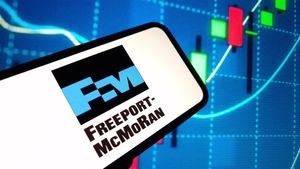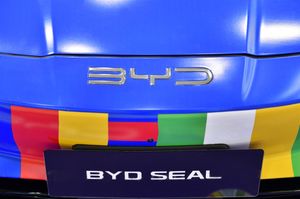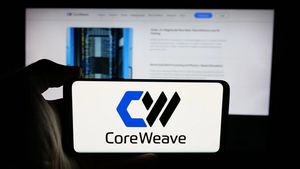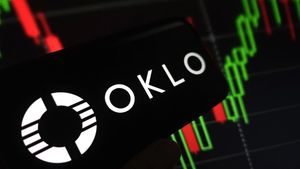
London, UK – September 26, 2025 – The decentralized finance (DeFi) landscape is abuzz with anticipation as Dexari, a prominent mobile-first, self-custodial trading platform, officially announced its "Gladiator Arena: ROI Trading Competition." Set to commence on October 1st, 2025, this month-long event promises a colossal prize pool starting at $100,000 USDC and scaling up to a staggering $1 million USDC, contingent on trading volume. The initiative marks a significant push to elevate engagement and inject substantial liquidity into the DeFi ecosystem, particularly through innovative incentive structures and strategic partnerships.
The competition's unveiling on September 26th, 2025, immediately sent ripples through the digital asset community, signaling a fresh wave of competitive trading and user acquisition strategies within decentralized exchanges (DEXs). By focusing solely on Return on Investment (ROI) as its ranking metric, Dexari (DEXARI:DXR) aims to spotlight genuine trading prowess, attracting seasoned and aspiring traders alike to its platform, which is powered by Hyperliquid (HYPER:HLY). This move is poised to intensify the race among DeFi platforms to capture market share and user attention in an increasingly crowded and dynamic sector.
Gladiator Arena: A Deep Dive into Dexari's High-Stakes Challenge
The "Gladiator Arena: ROI Trading Competition" is meticulously designed to be a high-octane, month-long battle of wits and strategy for DeFi traders. Kicking off on October 1st, 2025, the competition's core mechanic revolves around achieving the highest possible Return on Investment (ROI), a clear and performance-driven metric that aims to reward skill and strategic execution. This straightforward approach differentiates it from competitions that might factor in volume or other less direct indicators of trading success.
The prize pool, a major draw, is structured to incentivize widespread participation and significant trading activity. It begins at a substantial $100,000 USDC but possesses an impressive scaling mechanism: for every $1 billion in total trading volume generated across the platform during the competition period, the prize pool will increase by $50,000 USDC, up to a maximum of $1 million USDC. This dynamic scaling directly ties user engagement to potential rewards, creating a powerful feedback loop. The top performer stands to claim a hefty 35% of the total prize pool, meaning a potential windfall of up to $350,000 USDC if the maximum prize is reached. Crucially, there is no entry fee, lowering the barrier to participation and encouraging a broader spectrum of traders to join. Participants will also benefit from double Dexari Points throughout the event, adding another layer of incentive.
Dexari's strategic partnerships are a key component of this initiative. The competition is not just about the main prize; it also offers participants the chance to unlock side rewards from a host of Hyperliquid (HYPER:HLY) ecosystem partners. These include notable names such as Hyperliquid Names (HYPN:HLYN), Hypio (HYPIO:HIO), PiP (PIP:PIP), Pear Protocol (PEAR:PRL), Otties (OTTIE:OTT), Locals Only (LOCAL:LOC), Hyperpie (HYPE:HPI), and Racks.win (RACK:RKS). This collaborative approach not only enriches the reward structure but also fosters a stronger, more interconnected DeFi ecosystem, demonstrating how various protocols can synergize to create greater value for users. The simultaneous launch of Dexari's affiliate program further amplifies its user acquisition strategy, allowing affiliates to earn up to 80% of trading fees from referred users, thereby building a robust community-driven growth model.
Initial reactions from the market and industry have been largely positive, with many analysts pointing to the competition as a smart move to boost Dexari's profile and liquidity. The substantial prize money, coupled with the clear ROI metric and the absence of an entry fee, is expected to attract a significant influx of traders, potentially leading to a surge in trading volumes on the platform. This event is seen as a bellwether for how DeFi platforms are evolving their strategies to maintain relevance and competitiveness in a rapidly maturing market.
Market Movers: Winners and Losers in the DeFi Arena
The Dexari "Gladiator Arena" competition is poised to create distinct winners and losers within the competitive decentralized finance (DeFi) landscape, influencing various public companies and protocols directly and indirectly.
Potential Winners:
- Dexari (DEXARI:DXR) itself: As the host platform, Dexari stands to be the primary beneficiary. The competition is designed to dramatically increase its trading volume, user base, and overall liquidity. A successful competition could solidify its position as a leading mobile-first, self-custodial trading platform, attracting long-term users even after the event concludes. Increased activity often translates to higher trading fees, boosting the platform's revenue and potentially its native token value if applicable.
- Hyperliquid (HYPER:HLY) and its Ecosystem Partners: Given that Dexari is powered by Hyperliquid, and many side rewards are offered by Hyperliquid ecosystem partners, these entities are clear winners. Hyperliquid will likely see increased network activity and potentially higher demand for its underlying infrastructure. Partners like Hyperliquid Names (HYPN:HLYN), Hypio (HYPIO:HIO), PiP (PIP:PIP), Pear Protocol (PEAR:PRL), Otties (OTTIE:OTT), Locals Only (LOCAL:LOC), Hyperpie (HYPE:HPI), and Racks.win (RACK:RKS) will gain significant exposure, new users, and potentially increased utility for their respective offerings through the side rewards and cross-promotion. This collaborative model strengthens the entire Hyperliquid ecosystem.
- DeFi Analytics and Data Providers: Platforms that provide data, analytics, and trading tools for DeFi users could see increased traffic and subscriptions as traders seek an edge in the competition. Companies like Nansen (NANS:NAN), Dune Analytics (DUNE:DUN), or similar data aggregators might experience a surge in demand for their premium services as participants attempt to optimize their strategies.
- Stablecoin Providers: The $1M prize pool is denominated in USDC, a stablecoin. This competition, and others like it, drives demand for stablecoins as the preferred medium for competition prizes and trading capital, indirectly benefiting issuers like Circle (CRCL:USDC) or Tether (USDT:USDT) by increasing their stablecoin circulation and utility within the DeFi space.
Potential Losers (or those facing increased pressure):
- Competing Decentralized Exchanges (DEXs): Other perpetual DEXs or spot DEXs that do not offer similar high-incentive programs might experience a temporary or even sustained outflow of liquidity and active traders to Dexari. Platforms like dYdX (DYDX:DYDX), GMX (GMX:GMX), or Kwenta (KWEN:KWE) could face increased pressure to innovate their own incentive structures to retain their user base. This heightened competition could lead to reduced trading volumes or slower growth for platforms unable to match Dexari's aggressive engagement strategy.
- Centralized Exchanges (CEXs): While not direct competitors in the same sense, the allure of large prize pools and the growing sophistication of DeFi platforms like Dexari could draw some traders away from centralized exchanges such as Binance (BNB:BNB), Coinbase (NASDAQ: COIN), or Kraken (KRAK:KRA). As DeFi offers increasingly professional-grade tools with self-custody benefits, CEXs might need to redouble efforts to highlight their own advantages, such as fiat on-ramps and regulatory compliance, to prevent user migration.
- Smaller, Less-Funded DeFi Protocols: Protocols with limited marketing budgets or less robust incentive mechanisms may find it harder to attract and retain users in the face of such large-scale, well-funded competitions. This could exacerbate the "rich get richer" phenomenon in DeFi, where platforms with strong backing can afford to offer more attractive incentives, potentially marginalizing smaller players.
In essence, the "Gladiator Arena" competition will act as a significant market event, redistributing attention, liquidity, and potentially talent within the DeFi trading sector, forcing both competitors and partners to adapt their strategies in response.
Wider Significance: A Catalyst for DeFi Evolution
The Dexari "Gladiator Arena" competition transcends a mere promotional event; it represents a significant inflection point in the broader evolution of the decentralized finance (DeFi) industry. Its implications extend to industry trends, competitive dynamics, and even potential regulatory considerations.
Firstly, this event squarely fits into the broader industry trend of gamification and incentive-driven growth within DeFi. As the market matures, simply offering a decentralized trading venue is no longer sufficient. Protocols are increasingly leveraging large-scale competitions, liquidity mining programs, and token incentives to attract and retain users. Dexari's $1M prize pool, tied directly to trading volume, is a prime example of this strategy, pushing the boundaries of what platforms are willing to offer to stimulate activity. This trend suggests a future where sustained user engagement in DeFi will heavily rely on innovative incentive mechanisms.
Secondly, the competition will undoubtedly create ripple effects on competitors and partners. For other decentralized exchanges (DEXs), especially those focused on perpetuals trading, Dexari's move sets a new benchmark for user acquisition campaigns. Competitors like dYdX (DYDX:DYDX), GMX (GMX:GMX), or even newer entrants will likely feel pressure to respond with their own compelling incentives, potentially leading to an "arms race" of prize pools and trading rewards. This intense competition could ultimately benefit users through better trading conditions and more lucrative opportunities. For Dexari's partners within the Hyperliquid (HYPER:HLY) ecosystem, the competition offers unprecedented cross-promotional opportunities, demonstrating the power of collaborative growth in a fragmented market.
From a regulatory or policy implication standpoint, while directly unregulated, the sheer scale of the prize money and the focus on trading performance could draw increased attention from financial regulators. As DeFi moves towards larger user bases and more substantial capital flows, authorities might scrutinize such competitions for elements like market manipulation risks, fair play, and consumer protection. While Dexari's ROI-based metric aims for transparency, the overall trend of high-stakes DeFi competitions could contribute to the ongoing debate around appropriate regulatory frameworks for decentralized financial activities. It also highlights the global nature of DeFi, operating across jurisdictions without a single governing body.
Historically, large-scale trading competitions are not new to financial markets, with precedents in traditional finance (TradFi) and early crypto days. However, the "Gladiator Arena" stands out due to its self-custodial, mobile-first nature and its integration within a complex DeFi ecosystem. Unlike centralized exchange competitions, participants maintain full control over their assets. This event can be compared to the early trading contests that helped establish platforms like BitMEX or FTX (FTX:FTXQ) (prior to its collapse), but with the added layer of decentralization and composability inherent to DeFi. It signifies a maturation of decentralized trading platforms, capable of orchestrating sophisticated, high-value events that rival their centralized counterparts in scope and appeal.
What Comes Next: Navigating the Future of DeFi Engagement
The launch of Dexari's "Gladiator Arena" competition sets the stage for several short-term and long-term possibilities, shaping the trajectory of DeFi engagement and market dynamics.
In the short-term, immediate outcomes will revolve around the competition's execution and market response. We can expect a significant surge in trading volume on Dexari's platform starting October 1st, 2025, as traders flock to participate. This influx will test the platform's infrastructure and liquidity depth. Success in attracting high volumes could rapidly elevate Dexari's market position. Concurrently, other DEXs may observe a temporary dip in activity as traders shift focus, prompting them to quickly strategize counter-incentives or marketing pushes to retain their user base. The performance of Hyperliquid (HYPER:HLY) and its ecosystem partners, benefiting from increased exposure, will also be a key indicator of the competition's broader impact.
Looking into the long-term, the competition could catalyze several strategic pivots and adaptations across the DeFi landscape. If Dexari successfully converts a significant portion of competition participants into long-term users, it could validate aggressive incentive-driven growth models for other protocols. This might lead to an escalation in the scale and frequency of such trading contests, potentially making them a standard feature of DeFi platforms rather than an exception. Platforms unable to compete on prize pool size might need to differentiate through unique features, superior user experience, or niche market focus. The event also highlights the increasing importance of mobile-first design in DeFi, pushing other protocols to prioritize accessibility and user-friendliness on mobile devices.
Market opportunities or challenges will undoubtedly emerge. For investors, the increased volatility and trading activity around the competition could present opportunities for short-term gains, particularly in tokens related to Dexari or the Hyperliquid ecosystem. However, it also introduces challenges, such as the risk of "wash trading" or other manipulative tactics, despite the ROI-focused metric, as participants vie for top spots. The overall health of the DeFi market, particularly regarding gas fees and network congestion on underlying blockchains, will also influence the competition's smoothness and participant satisfaction.
Potential scenarios and outcomes include:
- Massive Success: Dexari achieves its maximum $1M prize pool, cementing its status and forcing competitors to innovate drastically. This leads to a new era of high-stakes, gamified DeFi trading.
- Moderate Success: The competition attracts substantial volume but doesn't hit the maximum prize, still providing a significant boost to Dexari and its partners, but perhaps not triggering an immediate "arms race" among competitors.
- Underperformance: Despite the prize, participation or volume falls short, suggesting that even large incentives have limits, or that other factors (e.g., market conditions, platform features) are more critical for sustained growth. This scenario would prompt a re-evaluation of incentive strategies across the industry.
Ultimately, the "Gladiator Arena" serves as a crucial experiment in DeFi engagement, providing valuable insights into user behavior, platform scalability, and the effectiveness of large-scale incentives.
Comprehensive Wrap-Up: A New Chapter for DeFi Engagement
The Dexari "Gladiator Arena: ROI Trading Competition" is more than just a contest; it represents a significant strategic maneuver designed to reshape user engagement and liquidity dynamics within the decentralized finance (DeFi) sector. As it prepares to launch on October 1st, 2025, the industry watches keenly to see how this ambitious initiative, with its potential $1 million USDC prize pool, will unfold and what lasting impact it will have.
Key takeaways from this event are manifold. Firstly, it underscores the intensifying competition among decentralized exchanges (DEXs) to attract and retain users, pushing platforms to innovate beyond core trading functionalities. Secondly, the competition highlights the growing importance of incentive mechanisms, particularly large cash prizes and gamified experiences, as powerful tools for driving trading volume and user acquisition in a mature DeFi market. Thirdly, the collaborative approach with Hyperliquid (HYPER:HLY) ecosystem partners demonstrates a trend towards interconnectedness and mutual growth within DeFi, where synergistic efforts can create greater value for all stakeholders. Finally, Dexari's mobile-first, self-custodial approach signifies a commitment to accessibility and user empowerment, catering to a broader demographic of traders.
Moving forward, the market will likely experience heightened activity and potentially increased volatility around Dexari and its associated tokens. Other DEXs will be closely monitoring the competition's success, and depending on the outcome, we could see a wave of similar incentive programs or, conversely, a strategic shift towards differentiation through unique technological advantages or niche market offerings. The "Gladiator Arena" serves as a real-time case study in market elasticity and the effectiveness of aggressive marketing within a decentralized environment.
Final thoughts on significance and lasting impact point to a potential paradigm shift in how DeFi protocols approach growth. If successful, Dexari's competition could set a new standard for user engagement, making large-scale, performance-based contests a regular feature of the DeFi landscape. This could foster a more dynamic, competitive, and ultimately, more liquid market for decentralized trading. It also reinforces the idea that innovation in DeFi is not just about underlying technology but also about creative strategies for community building and user attraction.
Investors should watch for several key indicators in the coming months. Firstly, monitor the total trading volume on Dexari during the competition to gauge its success in scaling the prize pool. Secondly, observe the user retention rates post-competition to understand if the initial surge translates into sustained platform loyalty. Thirdly, keep an eye on how competing DEXs respond, as their counter-strategies could reveal new trends in the market. Finally, assess the performance and adoption of Hyperliquid and its ecosystem partners, as their collective growth will be a strong indicator of the broader health and collaborative spirit of this segment of DeFi.
This content is intended for informational purposes only and is not financial advice





